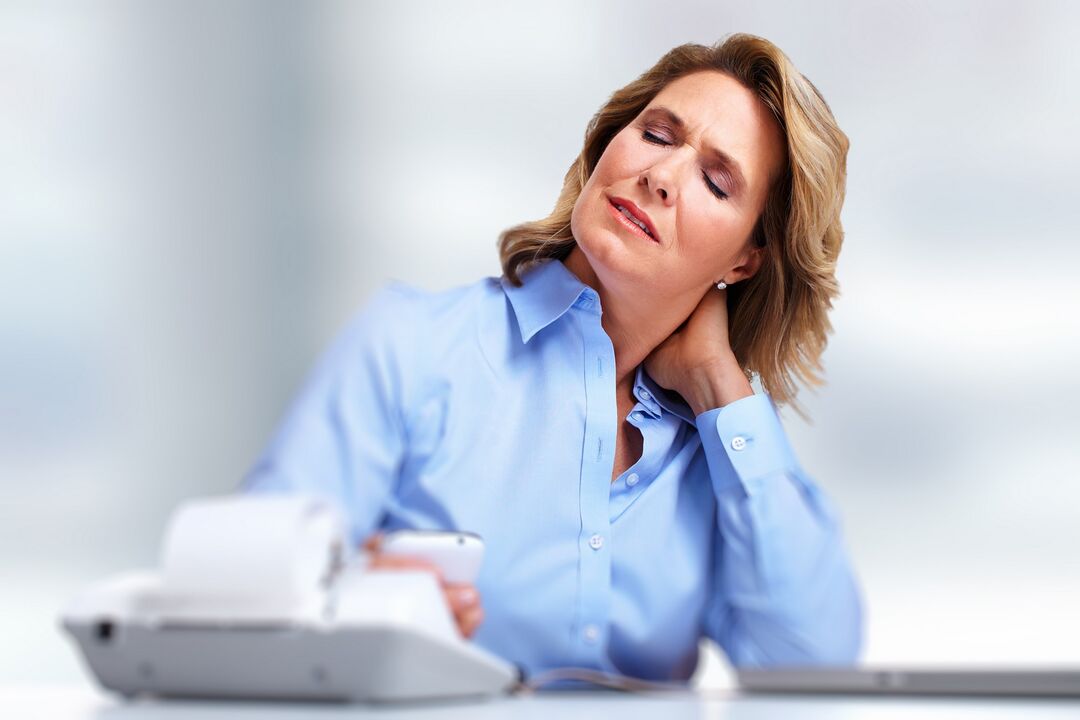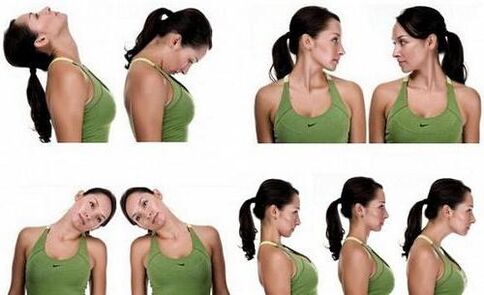
Osteochondrosis of the cervical spine (CS) is one of the most common pathologies of the musculoskeletal system. Every year, doctors diagnose this disease more and more often, and its course becomes more and more difficult. According to statistics, degenerative-dystrophic changes in the upper part of the spine occur more often in women, especially in postmenopausal patients. The main symptoms of cervical osteochondrosis in women are pain, limited mobility and cerebrovascular insufficiency, which is dangerous not only for health, but also for life. In order to protect yourself from the dangerous consequences of the pathology, you must start its treatment in the early stages. It is important to carry out complex therapy and change the way of life in order to stop the destruction of the spinal segments and prevent serious complications.
Disease development
The spinal column is the most sensitive to various injuries and degenerative changes. This is due to the fact that this segment is the most mobile, and the muscles here are weak. The small cervical vertebrae endure heavy loads every day, which leads to the gradual destruction of the intervertebral discs. The vertebrae press against each other, which causes the cartilage pads between them to lose a lot of fluid and begin to break down and deform.
In addition, osteochondrosis of the cervical spine develops due to insufficient nutrition of cartilage tissue. And the spinal canal in this area is narrow, so it is often compressed, which causes neurological symptoms.
Pathology in women in the early stages is manifested by heaviness in the back of the head, tingling in the hands, etc. Patients often confuse the first signs of illness with fatigue.
There are a large number of blood vessels and nerve roots in the neck area, and neurological disorders can occur when compressed. It is especially dangerous if the deformed disc or vertebrae compress the vertebral artery, which supplies important parts of the brain. When it is compressed, coordination of movements is disturbed, a woman can lose her balance, her vision and hearing deteriorate, and the risk of stroke increases.
Reference.According to statistics, cervical osteochondrosis is most often found in patients aged 25-40 years. This is due to a large reduction in physical activity and sedentary work. Women are more often diagnosed with the disease than men, because they have more fragile vertebrae and thin bone tissue.
Doctors distinguish 4 stages of osteochondrosis of the spine:
- Phase 1- the intervertebral disc loses part of its moisture, its height decreases, and cracks may appear on the fibrous ring (outer sheath). This is the stage of cervical chondrosis, which is difficult to recognize, because it has unexpressed symptoms. The neck gets tired quickly, there is discomfort, heaviness in the damaged area, sometimes there is a mild pain that passes quickly.
- Phase 2- the cracks on the surface of the disc increase, the nucleus pulposus (the gelatinous content of the disc) moves and can protrude through the damaged areas. This is how cartilage protrusions appear that can compress the spinal cord and its roots. Occasionally, severe pain, weakness, limited mobility occur, and numbness of the face, neck, shoulders, and arms may also occur.
- Phase 3– the protrusion pierces the outer shell of the disc and thus forms a hernia. The pain becomes more pronounced, and neurological disorders are also present.
- Phase 4- the disc is almost completely destroyed, the vertebrae rub against each other, and bone growths (osteophytes) appear on their edges, which are designed to stabilize the damaged segment. Nerve endings, spinal cord and blood vessels were injured. Adjacent joints begin to be damaged. Clinical signs are pronounced.
It is easiest to stop degenerative-dystrophic changes in the first two stages of osteochondrosis of the spine. In stage 3, comprehensive treatment will help stop further destruction of the spinal segment. In the last stage, surgery cannot be avoided.
Causes
Osteochondrosis of the spine is a complex and long-term process, which usually has several causes. In most cases, the pathology occurs due to a sedentary lifestyle, poor diet and metabolic disorders. Often the disease occurs due to an injury or due to the natural aging of the organism and the weakening of its defenses.
Doctors identify the main causes of osteochondrosis of the spine in women:
- Violation of metabolic processes.
- Passive lifestyle.
- Genetic predisposition.
- Chronic muscle tension around the cervical segment.
- Postural distortion.
- Lack of fluids and nutrients in the body.
- Prolonged stay in an uncomfortable position (neck extended forward and back hunched).
- Excessive weight.
- Frequent wearing of high-heeled shoes.
- SHOP injuries.
- Lifting heavy objects.
- Autoimmune pathologies.
- Frequent stress, chronic fatigue.
- Hypothermia.
- Infectious diseases.
- Too long or short neck, etc.
All these factors cause malnutrition of the intervertebral discs and lead to their degeneration.
Female cervical osteochondrosis can be caused by pathologies of the vertebral artery associated with genetic predisposition, intrauterine disorders and injuries during childbirth. The disease can occur due to rheumatism, endocrine disorders, excessive load on the cervical segment during pregnancy and local overload.
Important.The main cause of cervical osteochondrosis in women is menopause, as well as the changes associated with this period. In this phase, the concentration of progesterone in the body decreases, which is very important for bone tissue. The likelihood of degenerative changes is associated with aging of the weakening of the neck muscles and the weakening of the spine's support in this area.
Symptoms
Osteochondrosis is characterized by an undulating course, when the acute period is replaced by remission. Aggravation can be caused by infections, injuries, hypothermia and prolonged stress on the neck.

The first signs of cervical osteochondrosis in women are headache, discomfort and heaviness in the neck. It is important to distinguish pain due to chondrosis from migraine or autonomic dysfunction in time.
Clinical manifestations of osteochondrosis of the spine in women are caused by neurological syndromes:
- Cervical dyscalgia occurs when nerve endings are irritated by fragments of damaged cartilage. Then there is a specific crunch in the neck, pain that becomes more pronounced when moving the head and after sleeping.
- Scalenus syndrome is the result of damage to the vessels and nerves of the brachial plexus and the subclavian artery. This complex of symptoms is accompanied by pain from the inner surface of the shoulder to the hand on the side of the injured side. The limb becomes pale, cold, swollen and numb. Neck pain spreads to the back of the head when the patient turns his head.
- Humeral periarthrosis syndrome - dystrophic changes affect tendon fibers surrounding the shoulder. Painful sensations from the neck radiate to the shoulder and shoulder girdle. There is a forced position of the neck - it is tilted to the diseased side, and the shoulder is slightly lowered.
- Vertebral artery syndrome - the blood vessel is compressed by fragments of a damaged disc or osteophytes (depending on the stage of the disease). The patient feels dizzy and headache, nausea, and sometimes vomiting. The pain is localized in the back of the head, crown and temples.
- Cardiac – the nerve bundles of the spinal cord are damaged. Heart pain and arrhythmia occur. If C3 is damaged, pain occurs in half of the neck, the tongue swells, and the patient cannot chew food normally. If C4 is injured, then discomfort occurs in the area of the shoulder girdle, collarbone and heart. When C5 is affected, the pain response from the neck spreads to the shoulder girdle, the inner surface of the shoulder. C6 irritation causes pain from the neck and shoulder blade to the shoulder girdle and spreads through the hand to the thumb. If C7 is damaged, the pain syndrome spreads to the back of the shoulder girdle, affecting the entire hand, including the index and middle fingers. When C8 is pressed, the pain spreads from the affected area to the elbow and little finger.
Also, a woman's emotional sphere may be disturbed, weakness may occur, she becomes anxious and sensitive. Insomnia often occurs, memory and attention are weakened due to regular headaches.
Symptoms of a cerebrovascular accident occur when a woman suddenly throws her head back, tilts it, or does work that stresses the arms and cervical spine, for example, when digging, painting the ceiling, or carrying heavy objects.
Poor cerebral circulation is manifested by dizziness, unsteady gait, spots before the eyes, tinnitus, weakness and nausea. In some patients, the voice becomes hoarse, sometimes it disappears and a sore throat appears.
Osteochondrosis in menopause is accompanied by migraines, increased sweating of the body in the area between the neck and shoulder girdle. When the vertebral artery is compressed, the functioning of the cardiovascular system is disturbed.
If the disease lasts a long time, there is a failure of circulation in important centers that perform neuroendocrine functions. Due to the increased permeability of the vascular walls, atherosclerosis of the brain and heart arteries develops.
Establishing a diagnosis
If you notice symptoms of osteochondrosis, see a therapist. After a visual examination, the specialist will refer you to an orthopedist, vertebrologist or neurologist.
The following methods are used to diagnose cervical osteochondrosis:
- The X-ray allows us to discover that the patient's vertebrae are displaced, that there are osteophytes on their edges, that the distance between the vertebrae has decreased, etc. For this, the study is carried out in different planes. In order to detail the characteristic changes, the doctor takes targeted photographs.
- A CT scan of the cervical spine provides detailed information about pathological changes in the vertebrae. This method allows you to get three-dimensional images for a more detailed study; used in difficult diagnostic cases.
- MRI is used to accurately assess the state of soft tissues (nerves, blood vessels, ligaments, muscles) in the affected area.
- Electromyography allows you to check the conduction of the nerve fiber.
Doctors may also prescribe an ultrasound examination (Doppler ultrasound of the main arteries of the brain) to determine the state of blood flow in this area.
Conservative treatment
In the early stages, treatment of osteochondrosis of the spine in women can be carried out at home. However, the doctor must create a treatment regimen. It is important to understand that this is a long process and that full recovery is unlikely to be possible (especially for older women).
Complex treatment includes:
- Taking medication.
- Use of orthopedic aids.
- Physiotherapy.
- Physiotherapy procedures.
- Massage, manual influence.
- Alternative treatments.
Conservative methods will help relieve pain, inflammation, normalize muscle tone, improve metabolic processes, nourish damaged segments of the spine, etc. With timely therapy, it is possible to stop pathological changes.

Treatment of cervical osteochondrosis in women is carried out using drugs that will improve the metabolism of the cartilage pads between the vertebrae, relieve inflammation and pain. The following drugs are used for this purpose:
- NSAIDs. They will help relieve inflammation and pain of mild or moderate severity.
- Analgesics. It relieves pain.
- Medicines to improve cerebral circulation.
- Muscle relaxants help relieve muscle spasms.
- Chondroprotectors. They help stop disc destruction, improve metabolic processes and speed up recovery.
- Medicines based on magnesium.
- Nootropics. They stimulate the brain by normalizing its circulation and have a mild sedative effect.
Reference.For intense pain that is not relieved by oral medications, therapeutic blockades are used, for example, with an anesthetic solution or NSAIDs.
The treatment can be supplemented with anti-inflammatory and analgesic drugs in the form of gels, creams and ointments. They will be effective in the phase of remission or in combination with oral drugs.
The decision on choosing a combination of drugs is made by the doctor. The specialist will create a treatment regimen and determine their dosage. It is important to follow his recommendations, because many of the drugs described above can lead to dangerous complications.
During the acute phase of osteochondrosis of the spine, a woman should refuse heavy physical activities. To relieve the cervical segment, you need to wear a special corset (Schants collar), which will fix the vertebrae in the correct position. This device is recommended for use during prolonged sitting or heavy physical work.
Physiotherapy procedures will help relieve pain and improve blood circulation in the damaged area:
- Diadynamic therapy.
- Magnetotherapy.
- Electrophoresis with anesthetic, glucocorticosteroid, proteolytic agent.
- Electroanalgesia.
- Ultraviolet radiation, etc.
The therapeutic effect appears approximately after the third session, then headaches, hearing and vision disorders, dizziness weaken or disappear, sleep normalizes, and the general condition improves.
Using underwater traction of the cervical segment, you can widen the space between the vertebrae, release the nerve or blood vessel from compression and restore the normal position of the vertebrae.
Massage will normalize muscle tone and reduce the flow of lymph fluid, which causes swelling. After several sessions, blood circulation in the damaged area improves.

Therapeutic gymnastics is one of the most effective methods of treating osteochondrosis of the spine. Exercise therapy allows you to strengthen weak neck muscles, which will then take some of the load off the spine and help stop or slow down degenerative changes. During exercise, blood circulation improves, metabolic processes and disc nutrition are accelerated, which positively affects their condition.
Women should exercise every day. They consist of simple but effective exercises. The complex consists of turns, head tilts in different directions, as well as neck movements, where the hands are used. These elements can be performed at home, but only after a doctor's permission. Physical therapy is carried out only in the phase of remission.
The complex treatment can be supplemented with reflexology (acupuncture), hirudotherapy (treatment with leeches), swimming, etc.
Operation
The operation is prescribed in the last stages of osteochondrosis of the spinal cord, which are accompanied by serious destruction of osteochondral structures. Also, surgical intervention cannot be avoided if conservative methods are ineffective or the spinal canal has narrowed significantly.
In the above cases, anterior cervical discectomy is performed. During the procedure, the doctor immobilizes the damaged segment of the spinal column and removes the hernia that was pressing on the spinal nerve. Then the vertebrae between which the disc was removed fuse. If necessary, the space between the vertebrae is filled with a synthetic insert (cage).
After 3-5 days, the patient is discharged home. The rehabilitation period is about 12 weeks. In order to speed up recovery, you need to take medication, wear a corset, lead a healthy lifestyle, go to physiotherapeutic procedures and finally conduct exercise therapy.
Lifestyle recommendations
In order to quickly get rid of the unpleasant symptoms of osteochondrosis and stop degenerative-dystrophic changes in the cervical segment, you need to adjust your lifestyle. To do this, the patient must follow these recommendations:
- Go for a walk every day, avoid running, jumping and other explosive activities.
- Do not carry heavy objects.
- You cannot sit for a long time, in extreme cases wear a corset and occasionally take a horizontal position.
- At home, perform special physical exercises for the back muscles.
- Sleep on an orthopedic mattress and a special pillow.
- Follow a diet, supplement your diet with foods rich in magnesium, calcium (nuts, dairy products, seafood, legumes), as well as plant fiber, chondroitin (jelly, jelly). Avoid fatty, fried, overly salty foods and alcohol. Your doctor will advise you in more detail about the dietary rules. But in any case it must be true.
Hypothermia should not be allowed, warming will be useful in the absence of an inflammatory process.
Complications
In the absence of timely treatment of cervical osteochondrosis, a woman may experience the following consequences of the pathology:
- Probability of protrusion, which after some time turns into a hernia. The bulge compresses the spinal cord as well as its nerves, causing neurological disorders.
- Osteophytes appear when the disc is severely damaged and irritate the spinal nerves and blood vessels.
- In advanced cases, severe weakening of the neck muscles or incomplete paralysis is possible, then the head involuntarily hangs to the side or forward.
- Compression of vertebral arteries, impaired circulation in the affected area. This condition can cause neuralgia (pain along the nerve), hearing and vision problems.
- Paralysis (incomplete or complete) of the hand.
- Stroke, etc.
If a woman solves the problem in the early stages of osteochondrosis of the spinal cord, she will be able to prevent the conditions described above.
Preventive measures
Ideally, the prevention of osteochondrosis of the spine should be done during the period of intrauterine development. The future mother must exclude factors that negatively affect the development of the fetus: infections, oxygen starvation, intoxication. If there was a birth injury, the newborn must undergo treatment.
To reduce the likelihood of developing osteochondrosis of the spine, a woman should follow these recommendations:
- Load the spine evenly, for example, carry the load in both hands or alternately in the right and left.
- Do not lift too much weight yourself.
- Try to avoid neck injuries and hypothermia.
- While working in the gardens, take a break every 1. 5 hours and lie down to rest for 20 minutes.
- Choose shoes with an elastic sole that will cushion the impact while running or jumping.
- When sitting for long periods of time, use a chair with a high back and headrest or wear a corset.
It is also important to eat properly, control weight, avoid stress, take vitamin supplements for medical reasons and timely treat pathologies that can cause osteochondrosis. In the phase of remission, it is recommended to visit a sanatorium for treatment.
The most important
As you can see, osteochondrosis of the cervical spine occurs more often in women than in men, because the former have more fragile vertebrae and thin bone tissue. Postmenopausal patients are particularly susceptible to pathology. The disease is manifested by pain, neurological disturbances, as well as dangerous symptoms of cerebrovascular infarction. It is recommended to start treatment in the early stages to avoid dangerous complications of osteochondrosis. To do this, a woman must take medication, adjust her lifestyle, attend physiotherapeutic procedures, massage, do physical therapy, etc. Surgical treatment is indicated only in advanced cases. To prevent pathology, you must maintain moderate physical activity, timely treat injuries and diseases that can cause osteochondrosis, etc.

























